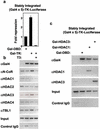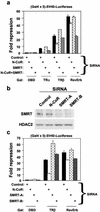The N-CoR/histone deacetylase 3 complex is required for repression by thyroid hormone receptor
- PMID: 12861000
- PMCID: PMC165720
- DOI: 10.1128/MCB.23.15.5122-5131.2003
The N-CoR/histone deacetylase 3 complex is required for repression by thyroid hormone receptor
Abstract
Nuclear receptor corepressors (N-CoR) and silencing mediator for retinoid and thyroid receptors (SMRT) have both been implicated in thyroid hormone receptor (TR)-mediated repression. Here we show that endogenous N-CoR, TBL1, and histone deacetylase 3 (HDAC3), but not HDAC1, -2, or -4, are recruited to a stably integrated reporter gene repressed by unliganded TR as well as the orphan receptor RevErb. Unliganded TR also recruits this complex to a transiently transfected reporter, and transcriptional repression is associated with local histone deacetylation that is reversed by the presence of thyroid hormone. Knockdown of N-CoR using small interfering RNAs markedly reduces repression by the TR ligand binding domain in human 293T cells, whereas knockdown of SMRT has little effect. RevErb repression appears to involve both corepressors in this system. Knockdown of HDAC3 markedly reduces repression by both TR and RevErb, while knockdown of HDAC1 or 2 has more modest, partly nonspecific effects. Thus, HDAC3 is critical for repression by multiple nuclear receptors and the N-CoR HDAC3 complex plays a unique and necessary role in TR-mediated gene repression in human 293T cells.
Figures






Similar articles
-
Recruitment of N-CoR/SMRT-TBLR1 corepressor complex by unliganded thyroid hormone receptor for gene repression during frog development.Mol Cell Biol. 2004 Apr;24(8):3337-46. doi: 10.1128/MCB.24.8.3337-3346.2004. Mol Cell Biol. 2004. PMID: 15060155 Free PMC article.
-
Both corepressor proteins SMRT and N-CoR exist in large protein complexes containing HDAC3.EMBO J. 2000 Aug 15;19(16):4342-50. doi: 10.1093/emboj/19.16.4342. EMBO J. 2000. PMID: 10944117 Free PMC article.
-
The N-CoR complex enables chromatin remodeler SNF2H to enhance repression by thyroid hormone receptor.EMBO J. 2006 Sep 6;25(17):3966-74. doi: 10.1038/sj.emboj.7601280. Epub 2006 Aug 17. EMBO J. 2006. PMID: 16917504 Free PMC article.
-
Modulation of thyroid hormone receptor silencing function by co-repressors and a synergizing transcription factor.Biochem Soc Trans. 2000;28(4):386-9. Biochem Soc Trans. 2000. PMID: 10961925 Review.
-
The Role of Histone Deacetylase 3 Complex in Nuclear Hormone Receptor Action.Int J Mol Sci. 2021 Aug 24;22(17):9138. doi: 10.3390/ijms22179138. Int J Mol Sci. 2021. PMID: 34502048 Free PMC article. Review.
Cited by
-
The silencing mediator of retinoic acid and thyroid hormone receptor (SMRT) corepressor is required for full estrogen receptor alpha transcriptional activity.Mol Cell Biol. 2007 Sep;27(17):5933-48. doi: 10.1128/MCB.00237-07. Epub 2007 Jun 25. Mol Cell Biol. 2007. PMID: 17591692 Free PMC article.
-
Regulation of relB in dendritic cells by means of modulated association of vitamin D receptor and histone deacetylase 3 with the promoter.Proc Natl Acad Sci U S A. 2005 Nov 1;102(44):16007-12. doi: 10.1073/pnas.0506516102. Epub 2005 Oct 20. Proc Natl Acad Sci U S A. 2005. PMID: 16239345 Free PMC article.
-
Transcriptional Regulation of Hepatic Autophagy by Nuclear Receptors.Cells. 2022 Feb 10;11(4):620. doi: 10.3390/cells11040620. Cells. 2022. PMID: 35203271 Free PMC article. Review.
-
HDAC3 is negatively regulated by the nuclear protein DBC1.J Biol Chem. 2010 Dec 24;285(52):40830-7. doi: 10.1074/jbc.M110.153270. Epub 2010 Oct 28. J Biol Chem. 2010. PMID: 21030595 Free PMC article.
-
Global histone profiling by LC-FTMS after inhibition and knockdown of deacetylases in human cells.J Chromatogr B Analyt Technol Biomed Life Sci. 2009 Nov 15;877(30):3885-92. doi: 10.1016/j.jchromb.2009.09.042. Epub 2009 Oct 1. J Chromatogr B Analyt Technol Biomed Life Sci. 2009. PMID: 19828382 Free PMC article.
References
-
- Alland, L., R. Muhle, H. Hou, J. Potes, L. Chin, N. Schreiber-Agus, and R. A. DePinho. 1997. Role for N-CoR and histone deacetylase in Sin3-mediated transcriptional repression. Nature 387:49-55. - PubMed
-
- Ayer, D. E., Q. A. Lawrence, and R. N. Eisenman. 1995. Mad-Max transcriptional repression is mediated by ternary complex formation with mammalian homologs of yeast repressor Sin3. Cell 80:767-776. - PubMed
-
- Brent, G. A., M. K. Dunn, J. W. Harney, T. Gulick, P. R. Larsen, and D. D. Moore. 1989. Thyroid hormone aporeceptor represses T3-inducible promoters and blocks activity of the retinoic acid receptor. New Biol. 1:329-336. - PubMed
-
- Chen, J. D., and R. M. Evans. 1995. A transcriptional co-repressor that interacts with nuclear hormone receptors. Nature 377:454-457. - PubMed
Publication types
MeSH terms
Substances
Grants and funding
LinkOut - more resources
Full Text Sources
Other Literature Sources
Research Materials
Miscellaneous
